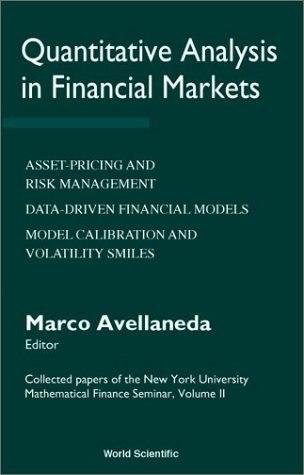
Quantitative Analysis in Financial Markets Collected papers of the New York University Mathematical Finance Seminar, Volume II
On Sale
$2.99
$2.99
It is a pleasure to edit the second volume of papers presented at the Mathematical Finance Seminar of New York University. These articles, written by some of the leading experts in financial modeling cover a variety of topics in this field. The volume is divided into three parts: (I) Estimation and Data-Driven Models, (II) Model Calibration and Option Volatility and (III) Pricing and Hedging. The papers in the section on "Estimation and Data-Driven Models" develop new econometric techniques for finance and, in some cases, apply them to derivatives. They showcase several ways in which mathematical models can interact with data. Andrew Lo and his collaborators study the problem of dynamic hedging of contingent claims in incomplete markets. They explore techniques of minimumvariance hedging and apply them to real data, taking into account transaction costs and discrete portfolio rebalancing. These dynamic hedging techniques are called "epsilon-arbitrage" strategies. The contribution of Yacine Ait-Sahalia describes the estimation of stochastic processes for financial time-series in the presence of missing data. Andreas Weigend and Shanming Shi describe recent advances in nonparametric estimation based on Neural Networks. They propose new techniques for characterizing time-series in terms of Hidden Markov Experts. In their contribution on the statistics of prices, Geman, Madan and Yor argue that asset price processes arising from market clearing conditions should be modeled as pure jump processes, with no continuous martingale component. However, they show that continuity and normality can always be obtained after a time change. Kaushik Ronnie Sircar studies dynamic hedging in markets with stochastic volatility. He presents a set of strategies that are robust with respect to the specification of the volatility process. The paper tests his theoretical results on market data.
The second section deals with the calibration of asset-pricing models. The authors develop different approaches to model the so-called "volatility skew" or "volatility smile" observed in most option markets. In many cases, the techniques can be applied to fitting prices of more general instruments. Peter Carr and Dilip Madan develop a model for pricing options based on the observation of the implied volatilities of a series of options with the same expiration date.
The second section deals with the calibration of asset-pricing models. The authors develop different approaches to model the so-called "volatility skew" or "volatility smile" observed in most option markets. In many cases, the techniques can be applied to fitting prices of more general instruments. Peter Carr and Dilip Madan develop a model for pricing options based on the observation of the implied volatilities of a series of options with the same expiration date.
